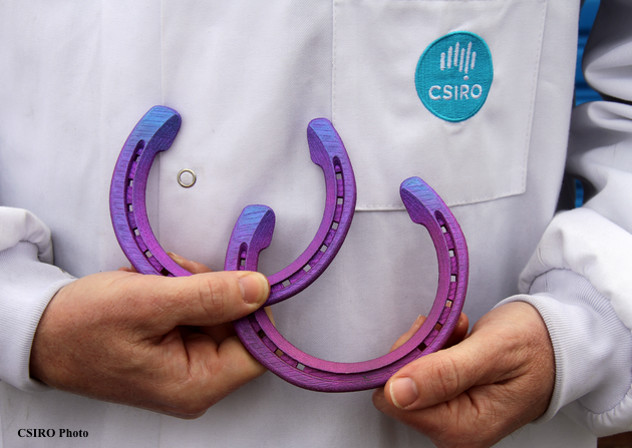
by Aidan Connolly
From the mythical tales of Pegasus and the Black Stallion to the true legacies of Alexander the Great’s Bucephalus and Man o’ War, few animals conjure up images of nobility, strength, beauty, power and freedom in our minds quite the same way a horse does. First domesticated 5,000 years ago in Europe and Asia, the role of the horse throughout history has changed considerably, and these beautiful animals have demonstrated an incredible range of abilities and athleticism. While some cultures still rely on horses for transportation or agriculture, others primarily view the relationship with the horse as one of sport or pleasure.
Now a multibillion-dollar industry, the economic value of the business of horses is estimated to be $39 billion in the U.S. alone. Also evident are the opportunities to use new technology. While the progress of the past few years has been swift, the full potential hasn’t yet been realized. Eight digital technologies discussed in previous blogs have the potential to disrupt the equine industry, altering the very fundamentals of how we take care of horses. Image courtesy of © CSIRO Australia, 2013
1. 3D printing: The new farrier?
3D printers can provide nontraditional answers to traditional challenges. Through improved breeding and nutrition, the horse industry has been able to dramatically improve performance, but challenges remain, specifically injuries and irregular growth patterns.
3D printing could be used to create casts, splints or possibly prosthetics for animals with injured or broken legs. For every Seabiscuit, there are countless examples of valuable horses that are put down when they break a bone. Previously, the prognosis for such horses was very poor, but what if 3D printing could step in as a solution? With this tool, veterinarians could print any number of things to solve myriad health issues.
CSIRO in Australia has developed 3D horseshoe printing technology to generate horseshoes using imaging software that closely analyzes the hoof in order to provide shoes with a superior ergonomic fit. Farriers may very soon be using this technology to produce all manner of individually sized footwear for horses that can help alleviate chronic symptoms and aid in faster recovery.
2. Robots: For heavy horse lifting
Robotic technology is already replacing a host of repetitive tasks, particularly in manufacturing, and greatly reducing labor costs. In the horse industry, applications could actually save lives. Robots have the ability to lift a horse in a careful manner that controls weight distribution and reduces the risk of hurting horses in operations that could be life-threatening, such as broken legs or laminitis. One form of equine lift was designed through collaboration between the University of Saskatchewan and a machinery company called RMD Engineering, which had originally taken inspiration from the idea with people suffering from multiple sclerosis.
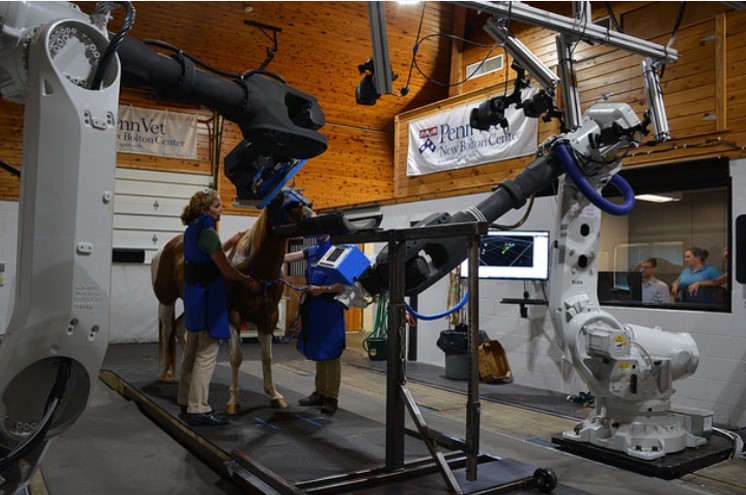
Robots can also help in equine medicine and the evolution of CT scans. Each year, hundreds of horses are fatally injured in North America due to racetrack injuries, mainly fractures. Getting an accurate scan of an animal as large as a horse can prove quite challenging, but robotic devices, such as the one created by 4DDI Equine, maneuver around the horse, reducing the need for the animal’s cooperation as well as providing a safer alternative to more traditional methods that may have involved heavier sedation, tranquilization or other anesthetics. Equimagine can scan the entire horse in 90 seconds, taking over 900 images and producing high-quality, multi-planar 3D (or even 4D!) images, all while the horse is awake and standing.
3. Drones: Too much like a horrendous horsefly?
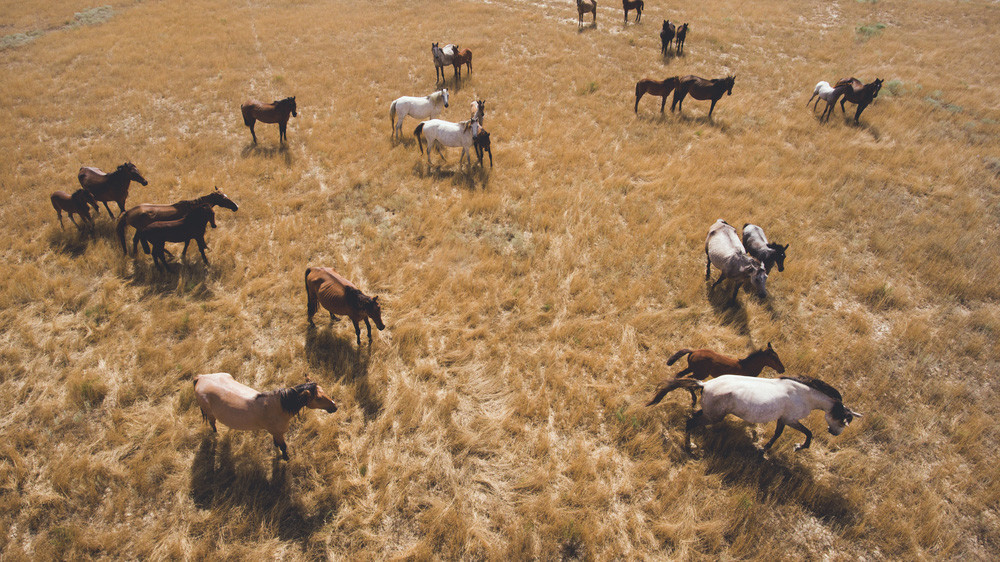
Their value is already well established in many areas of agriculture, such as monitoring crop growth and disease, but the role drones can play with horses has yet to be fully explored. The Bureau of Land Management could potentially use drones to monitor the population and movements of wild horses, without the requirement for helicopters or trackers, both of which pose their own challenges and limitations. It is also possible to imagine a future in which they could be used to deliver vaccines, antibiotics or other medical needs to veterinarians treating wild horses. At a more micro level, drones supplied with a camera, combined with machine vision, could be used to monitor the movement of a cantering or galloping horse in open spaces and to determine lameness or other idiosyncrasies not normally visible to the human observer.
Despite these positive applications, it is worth mentioning the concerns most horse people have with drones. They are, effectively, large horseflies that can cause fear, and possibly even harm, to horses that can be easily frightened by the loud hum, if not the hovering object in the sky. Death or injury of spooked horses has been reported on several occasions. Given that drones are still a relatively uncommon sight to humans, it is not likely that training for compatibility between horses and this technology is likely to become standard.
4. Sensors: From smart saddles to dressage scripts
Sensors have already established their position as a new powerful technology for horse management. They can be used to analyze many aspects of performance and health, and already over 80 companies provide wearable sensor technology for horses. The capabilities of this modern technology can help veterinarians and the equine industry immensely.
Seaver, for instance, is a wearable girth that measures a horse’s heart and breathing rate and uses algorithms to determine the animal’s movement when jumping to provide measurable data regarding its vertical and horizontal aspects. This is accessible via the rider’s smartphone app and can be stored and played back later for riders to assess the horse’s movement, path or strides. When repeated, it can determine changes over time. Arioneo has designed a wearable that attaches to a blanket and monitors a horse at rest.
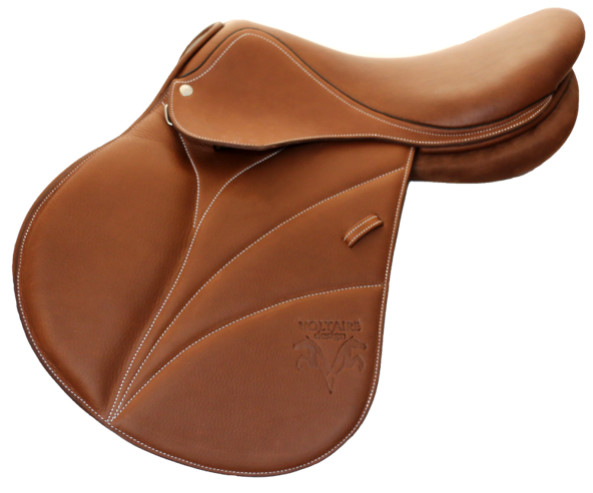
Well-known saddle maker Voltaire has developed the first smart saddle. The Blue Wing saddle is the first of its kind that is designed to actually benefit the horse while in use by collecting information and saving that information for review later by the rider. It does this using a chip in the saddle that collects information about each ride: time spent in each gait, direction, quality of the horse’s symmetry, number of jumps, etc. All of this can be reviewed later by the rider or trainer; adjustments to the training program can be made based on evaluation of the horse’s performance using these metrics.
Other sensors can detect lameness in a horse’s legs or back and assist veterinarians with diagnosis. Equinosis is one such company producing these sensors. It can determine lameness metrics that the human eye cannot see and using real time data collection, can give the veterinarian immediate feedback. The sensors are non-invasive so instrumentation is fast and simple.
Another smart, wearable gadget is the Nightwatch Smart Halter by Protequus, which uses microprocessors and sensors to provide 24-hour monitoring. If a horse is in distress, Nightwatch can send text messages or phone calls to the recipient. For sport and riding horses, GaitSmart Pegasus is a wearable designed to analyze a horse’s movements and produces a report within minutes.
Sensors may soon find their way into the dressage arena. Lemberg, a mobile and web development company, is attempting to use sensor technology to determine a rider’s location in the ring and give directions, or a “script,” to the rider as he or she performs the exercise. The company is testing different location technologies such as Xiaomi Mi4 or Apple’s iBeacons. Both offer location positioning technology without the use of satellites, thereby offering greater accuracy, which is necessary given that the arena is often covered and comparatively small, and the directions in dressage competition need to be extremely accurate and perfectly timed.
Another incredible advancement in sensor technology is a high-tech “camera pill” that allows veterinarians to see directly into the gut of the animal, thereby allowing for better diagnosis of disease, general health status or examination of surgical sites. Then there's Equilume, which provides a wearable combined with smart stable lighting to regulate and synchronize the internal clock improving performance and health.
Other tech companies producing equine sensors include SeeHorse, HorseAlarm, Equisense, EquinITy, Trackener, Connected.Horse, HorseAnalytics, and HorseCom.
These technologies offer owners insight into the daily health and well-being of their horse using real-time data. Potentially, this information could give veterinarians the opportunity to analyze and interpret massive amounts of information regarding both individual animals, and, if used collectively, to better understand the species as a whole.
5. Artificial intelligence (AI): More accurate training?
AI is the ability to gather information from sources, such as sensors or other data collection devices, and interpret that data to help make meaningful and logical decisions. AI eliminates interpretational errors by allowing for analysis of significantly larger data sets, thereby eliminating many mistakes that might occur with humans.
Equimetre is an AI-powered wearable offering insight to trainers in the horse racing industry by providing analysis of the animal while also collecting data about the conditions of the track, temperature, humidity, etc. In evaluating all of this data through AI, the company is able to provide analyses and recommendations to trainers that will best suit the horse. This technology could easily be transferred into other disciplines in the industry, including jumping, dressage, endurance or polo, or it could be used to make recommendations for racetrack betting, grossly altering the odds! Such was the case when CBS Interactive challenged Unanimous A.I. to predict a winner of the 2016 Kentucky Derby.
When combined with something like machine vision (such as the company Cainthus provides to dairy), it could segue into the equine world and provide insights into the daily routine and management of horses. Vetel Diagnostics is using its Intelligent Imaging™ software to identify radiographs, analyze bone density and even visually construct a leg from images taken. This technology can save veterinarians time, money as well as all types of new applications for learning and understanding.
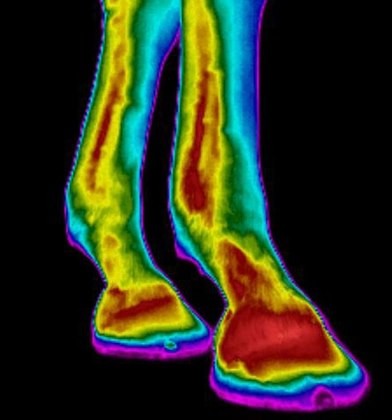
6. Augmented reality (AR): See where your horse hurts
Augmented reality is a combination of real-world visuals supplemented with information created from external data. The augmented portion of the image is provided by digital information interpreting light frequencies not visible to the human eye. The added visuals can be imposed on the real image in such a way that they are indistinguishable. Equine thermography, for example, uses a camera that detects infrared waves on the horse’s body surface that are invisible to the human eye. Veterinary Thermal Imaging, Ltd. uses this same information to detect issues in horses’ backs, ligaments and tendons, muscles, bones and nerves, often weeks before the animal is even showing signs of pain or injury, allowing for the opportunity to preventatively treat the animal.
The Equine Motion Analysis System is a software technology company that examines horse and rider symmetry. Designed by a computer programmer and equitation scientist, the program is designed to create an image depicting where a horse, rider and saddle are properly (or improperly) aligned.
Additionally, the future of horse racing betting could easily benefit from this type of technology. Using AR, bettors could more easily see what is happening on the track through the use of devices such as goggles; real vision could be supplemented with additional information such as speed, placement, and market or betting information. From a trainer’s perspective, more detailed information regarding the individual horse could be provided, thereby giving insight into the animal’s health status in real time. AR’s expense could be offset by the creation of new betting mechanisms. Companies like YantramStudio, Meta and Vuzix are the likely future of AR, and their use could be replicated in the equine industry.
7. Virtual reality (VR): A new way for vet's to train
Virtual reality provides a new tool for veterinarians and those training to work with horses. Complicated or rare surgeries could be practiced in a classroom ad libitum, minimizing the risk to students, technicians and teachers. Although expensive, VR has the ability to greatly reduce other costs, such as time and energy, as well as save an animal from enduring invasive procedures for the purpose of learning and training. As VR becomes more common and less expensive, it could be used in more mundane training for managers and workers.

It could also be used for equestrian-related entertainment. William Hill unveiled its latest horseracing prototype called “Get in the Race,” in which users can experience a live horse race (from the back of the horse!) in a 3D virtual environment. Unit9 has developed a polo playing experience using software such as Google Cardboard. If more companies such as Oculus Rift choose to get in the game, the potential for cost savings to users could greatly increase.
8. Blockchain: A secure, global network of horse information
Blockchain technology is possibly one of the most universally beneficial technologies transforming business today. Blockchain is a database of information contained across a network that uses a decentralized system of information management, thereby making it difficult to corrupt the information. It is basically a database where digital records can be stored by anyone, and security is guaranteed. It is public and transparent because all the information is embedded within a distributed network.
Historically, blockchain has been used primarily in the financial industry, but it can be applied to business. An individual company or user doesn’t need to understand how to manage it, but only how to use it. In the equine industry, blockchain allows buyers from all over the world to store valuable and trustworthy information about horses, prices, treatments, scientific studies, feeding and technology, etc. Essentially, any equine company can access the database and register anything about horses such as birth, surgery, injections, veterinary visits, injuries, height and weight, treatments and more. Increasingly, more federations are requiring microchipping in horses, including the United States Equestrian Federation and The Jockey Club. Microchip manufacturers are benefiting from this, but so will prospective horse owners, veterinarians and anyone else interested in learning more information about a specific animal if this information is also housed using blockchain technology.

Roping it all together
The old business models are being disrupted with these eight technologies. Combined, they can be part of the internet of things (IoT), a system in which everything is connected and sourceable. GMAX is already using IoT technology to connect various equine technologies and provide incredible amounts of data, interpretation, analysis and recommendations to users. Such applications can be transformative to the equine industry. EquInnolab provides educational opportunities for learning and collaboration involving these technologies within the equine industry.
Not since the invention of the saddle and stirrup have horse people had so many opportunities to reimagine the future. These technological changes are only the beginning. More improvements are ahead as equine digital technologies are further adapted and refined. What will the industry look like in five years? While that is hard to predict, we can know for certain that it won’t look like it has these past 5,000 years.
Many thanks to Douglas Solis and Kristen Brennan and Alexa Potocki for their contributions to this article.

About the Author - Aidan Conolly is an expert in Innovation in agribusiness. He is an agricultural instructor and a global traveler.
Do you have a new technology product? Email us at info@equineinfoexchange.com

































